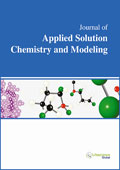jascm
Abstract : Sorption of the Simplest Carboxylic Acids on Clay-Like Mineral Glauconite: Reduction of Integral Toxicity of Aqueous Solutions
 Sorption of the Simplest Carboxylic Acids on Clay-Like Mineral Glauconite: Reduction of Integral Toxicity of Aqueous Solutions - Pages 55-61 Sorption of the Simplest Carboxylic Acids on Clay-Like Mineral Glauconite: Reduction of Integral Toxicity of Aqueous Solutions - Pages 55-61L.E. Tsygankova, M. Vigdorowitsch, A.A. Uryadnikov, E.D. Tanygina, O.V. Alyokhina and M.N. Uryadnikova DOI: https://doi.org/10.6000/1929-5030.2018.07.07 Published: 21 December 2018 |
Abstract: The integral toxicity of solutions of a number of carboxylic acids was estimated by measuring their chemical oxygen consumption (COC) and the biochemical oxygen demand for the biodegradation of substances due to microorganisms (BOD5). The analytical dependences of COC and BOD5 as well as of their ratio for these compounds on concentration were determined. The values of COC and BOD5 for a number of acid solution mixtures were measured. The coefficient that indicates biodegradability of substances has been calculated. The chemical consumption of oxygen by solutions of organic acids is shown to increase with the transition from lower to higher homologues and with increase in the concentration of the solution. |
Abstract : Modified Poly(ethylene terephthalate) Nano Fibers for Removal of Copper(II) Ions
 Modified Poly(ethylene terephthalate) Nano Fibers for Removal of Copper(II) Ions - Pages 1-6 Modified Poly(ethylene terephthalate) Nano Fibers for Removal of Copper(II) Ions - Pages 1-6Fariborz Azizinezhad DOI: https://doi.org/10.6000/1929-5030.2019.08.01 Published: 20 September 2019 |
Abstract: In this research, the adsorption of Cu2+ ions from aqueous solution was investigated by the modified poly (ethylene terephthalate) fibers as a new adsorbent. The best condition of electrospinning was recorded (voltage= 10 kV – distance from nozzle= 12.5 cm – solution convcentration= 0.2 g/mL). The optimum condition for removal of Cu2+ ions were determined (pH=10 – time= 60 min - C= 120 mg/L, qm = 62.4 mg/g). The adsorption data were best fitted by dubinin-radushkevich isotherm and pseudo-second order kinetic models, as well. Structure of the nanofibers were emphasized by scanning electron microscpy (SEM) and thermo gravimetric analysis (TGA). |
Abstract : How to Resolve the Problem of Drago's Four Parameters in the Context of Molecular Interactions
 How to Resolve the Problem of Drago's Four Parameters in the Context of Molecular Interactions - Pages 7-15 How to Resolve the Problem of Drago's Four Parameters in the Context of Molecular Interactions - Pages 7-15Ho Nam Tran and Buchmann Michel DOI: https://doi.org/10.6000/1929-5030.2019.08.02 Published: 02 October 2019 |
Abstract: This study aims to provide a new thermodynamic method for determining the value of Drago's four interaction parameters, namely Ea, Eb, Ca, and Cb (kcal1/2 mol-1/2). The method is based on the following fundamental novelties: The values of the parameters Ea, Eb, Ca, and Cb are simultaneously determined for seven amphoteric substances. Thus, there are a total of 28 values to be determined, with each set consisting of seven substances. For the seven selected amphoteric substances, there are seven equations of the type: |
Abstract : The Free-Radical Nonbranched-Chain Initiated Formation of Ethylene Glycol from Methanol–Formaldehyde Solutions
 The Free-Radical Nonbranched-Chain Initiated Formation of Ethylene Glycol from Methanol–Formaldehyde Solutions - Pages 1-5 The Free-Radical Nonbranched-Chain Initiated Formation of Ethylene Glycol from Methanol–Formaldehyde Solutions - Pages 1-5Michael M. Silaev DOI: https://doi.org/10.6000/1929-5030.2020.09.01 Published: 20 February 2020 |
Abstract: The mechanism and kinetics are developed for the free-radical nonbranched-chain initiated formation of ethylene glycol in methanol–formaldehyde solutions at formaldehyde concentrations of 0.1–3.1 mol dm–3 and temperatures of 373–473 K. The experimental concentrations of the free unsolvated form of formaldehyde are given at the different temperatures and total concentrations of formaldehyde in methanol. The experimental dependence of the radiation-chemical yields of ethylene glycol on formaldehyde concentration in γ-radiolysis of methanol–formaldehyde solutions at 373–473 K is shown. At a formaldehyde concentration of 1.4 mol dm–3 and T = 473 K, the radiation-chemical yield of ethylene glycol is 139 molecules per 100 eV. The effective activation energy of ethylene glycol formation is 25 ± 3 kJ mol–1. The quasi-steady-state treatment of the reaction network suggested here led to a rate equation accounting for the non-monotonic dependence of the ethylene glycol formation rate on the concentration of the free (unsolvated) form of dissolved formaldehyde. It is demonstrated that the peak in this dependence is due to the competition between methanol and CH2=O for reacting with adduct radical HOCH2CH2O•. |





















